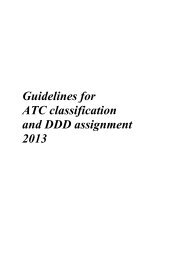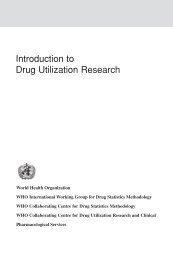Download - WHOCC
Download - WHOCC
Download - WHOCC
You also want an ePaper? Increase the reach of your titles
YUMPU automatically turns print PDFs into web optimized ePapers that Google loves.
3.3 Reporting<br />
The WHO Collaborating Centre is responsible for reporting all alterations to the ATCvet<br />
classification system to users of the system. Subscriptions to ATCvet alterations can be arranged<br />
free of charge with the WHO Collaborating Centre. ATCvet alterations are also available from<br />
the WHO Collaborating Centres website at www.whocc.no.<br />
All requests for new ATCvet codes, comments on existing ATCvet classifications and<br />
suggestions for alterations should be addressed to the WHO Collaborating Centre. The reasons<br />
for any proposed reclassification should also be given, preferably on the special application form<br />
(see Annex 1) which can be obtained from the WHO Collaborating Centre on request or<br />
downloaded from the WHO Collaborating Centres website.<br />
4. ATCvet Index<br />
The WHO Collaborating Centre for Drug Statistics Methodology publishes a new issue of the<br />
complete ATCvet Index annually. The complete ATCvet Index consists of one list sorted<br />
according to ATCvet codes, listing all the ATCvet codes established, and one list alphabetically<br />
sorted according to nonproprietory drug names, including all ATCvet 5 th levels. The Index is<br />
freely available on the website www.whocc.no or can be ordered as hard copy or as an electronic<br />
file from the WHO Collaborating Centre. The Guidelines for ATCvet classification is also<br />
available at the WHO Collaborating Centres website as a pdf file.<br />
The ATCvet system has been developed in association with the ATC system for human<br />
medicine, which is developed and maintained by the WHO Collaborating Centre for Drug<br />
Statistics Methodology in Oslo. The ATCvet system is based on the same main principles as the<br />
human ATC system, and the naming of levels is adapted from this system. Alterations and new<br />
codes in the ATC system are normally implemented also in the ATCvet system.<br />
In general the names of the levels are kept consistent with the human ATC system and all<br />
substances included in this system are listed. In some cases the level names in the human ATC<br />
system are not appropriate in veterinary medicine. As a consequence one change of ATCvet<br />
level name was implemented in the 2006 edition: QD05 is now named “Drugs for<br />
keratoseborrheic disorders (human ATC: Antipsoriatics)”.<br />
Applications for ATCvet codes for new drugs not yet classified are received by the WHO<br />
Collaborating Centre for Drug Statistics Methodology continuously in the course of the year.<br />
These applications are given ATCvet codes and the classifications are discussed by the ATCvet<br />
Working Group at the annual meeting in November. When the final decision has been taken, the<br />
new codes are included in the ATCvet Index.<br />
Lists of the annual ATCvet alterations are distributed in January each year free of charge to the<br />
users of the ATCvet system according to a mailing list, together with an order form for the new<br />
index.<br />
5. References<br />
1. WHO Collaborating Centre for Drug Statistics Methodology<br />
Guidelines for ATC classification and DDD assignment 2011. Oslo 2010.<br />
19





